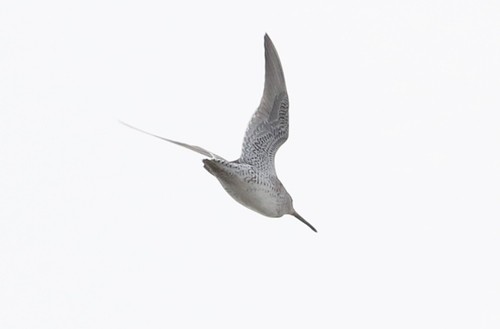Short-billed Dowitcher
A species of Dowitchers Scientific name : Limnodromus griseus Genus : Dowitchers
Short-billed Dowitcher, A species of Dowitchers
Botanical name: Limnodromus griseus
Genus: Dowitchers
Content
Description General Info
 Photo By silversea_starsong , used under CC-BY-NC-4.0 /Cropped and compressed from original
Photo By silversea_starsong , used under CC-BY-NC-4.0 /Cropped and compressed from original Description
The body of adults is dark brown on top and reddish underneath. The tail has a black and white barred pattern. The legs are a yellowish color. There are three subspecies with slight variations in appearance: L. g. griseus has a white belly and barred flanks. L. g. hendersoni has a reddish belly and spotted flanks. L. g. caurinus has a white belly with heavily barred flanks and densely spotted breast. None of these combines the reddish belly and barred flanks of the breeding plumage long-billed dowitcher. The winter plumage is largely grey. This bird can range from 23 to 32 cm (9.1 to 12.6 in) in length, 46 to 56 cm (18 to 22 in) in wingspan and 73–155 g (2.6–5.5 oz) in body mass. The call of this bird is more mellow than that of the long-billed dowitcher, and is useful in identification, particularly of the difficult adult plumages. 
Size
27-30 cm (10.5-12 in)
Colors
Brown
Black
Bronze
Gray
White
Life Expectancy
13 years
Nest Placement
Ground
Clutch Size
4 eggs
Feeding Habits
Short-billed Dowitcher search muddy substrates, using vertical probing for invertebrates like worms, mollusks, and crustaceans. They glean horseshoe crab eggs in spring, eat insect larvae, small plants, and occasionally pull large prey from burrows. They forage individually or in non-aggressive flocks, often by swiveling the body.
Habitat
Short-billed Dowitcher's preferred habitats include ecotones between boreal forests and arctic tundra for breeding, characterized by bogs and wet meadows. During migration, short-billed Dowitcher adapts to coastal environments such as estuaries and mudflats, also utilizing manmade habitats like salt ponds. In wintering grounds, short-billed Dowitcher may inhabit mangrove swamps in tropical regions, favoring areas with fine, muddy substrates for foraging.
Nest Behavior
The female short-billed Dowitcher selects the nest site from choices the male offers. Egg-laying and nest building occur in the selected spot. Parental care involves incubation and protection of the well-hidden nest and young by both parents.
Nest Characteristics
Short-billed Dowitcher nests in wet meadows at or near the treeline, often far from water bodies. Nests are set amid sedge or cotton grass, sometimes by small trees or shrubs. The male forms a depression lined with feathers, dry grasses, twigs, and plant matter, averaging 4.5 inches wide and 2 inches tall, concealed by vegetation.
Dite type
Aquatic invertebrate eater
General Info
Feeding Habits
Bird food type
Behavior
Short-billed Dowitcher exhibit distinct breeding behaviors, initiating courtship with spirited aerial displays and perched vocalizations upon arrival in their breeding territories. Males vigorously defend their chosen areas against rivals with assertive chases and displays. These birds form monogamous pairs, with both parents sharing incubation duties until hatching, after which the female departs and males take sole responsibility for the young. In contrast to their competitive breeding demeanor, short-billed Dowitcher are notably placid in mixed-species flocks during migration, often co-existing harmoniously with other shorebirds as they forage and travel.
Species Status
Not globally threatened.
Scientific Classification
Phylum
Chordates Class
Birds Order
Shorebirds Family
Sandpipers Genus
Dowitchers Species
Short-billed Dowitcher